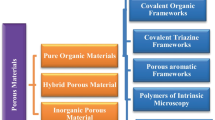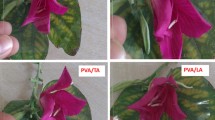Abstract
PANI:CuO hybrid nanocomposites at different wt ratio of ammonium per sulfate are prepared by the in-situ chemical polymerization method. Morphology and bonding changes are observed in pure PANI and PANI:CuO:APSx hybrid nanocomposites. The structural changes are observed in the PANI:CuO hybrid nanocomposites due to the induction of CuO in the hybrid from XRD pattern. FTIR study confirms the presence of dopant molecules in the molecular structure. UV–Vis spectra reveal the presence of two absorption peaks at 236 and 358 nm due to π–π* transition of PANI and the shifting of 358 nm PANI peak to 484 nm in the formed PANI:CuO (0.1 M of APS) nanocomposite. The PL spectra indicate the occurrence of a broad emission peak at 395 nm in the polymer composites. The pellets are made using hydraulic press under uniform pressure. These pellets are investigated by humidity sensing. Relative humidity sensing response shows the reverse behavior. Resistance is decreases with the increase in relative humidity range between 5 and 75%RH. However, the sensitivity is found to be dependent on the type of dopant anions. The composite based sensors show better sensitivity, linearity, and quicker response time.












Similar content being viewed by others
REFERENCES
A.G. MacDiarmid, Curr. Appl. Phys. 1, 269 (2001).
S. Koul, R. Chandra, and S. K. Dhawan, Sens. Actuators, B 75, 151 (2001).
A. Elmansouri. A. Outzourhit, A. Lachkar, N. Hadik, A. Abouelaoualim, M. E. Achour, A. Oueriagli, and E. L. Ameziane, Synth. Met. 159, 292 (2009).
M. V. Fuke, A. Vijayan, M. Kulkarni, R. Hawaldar, and R. Aiyer, Sens. Actuators, B 76, 1035 (2008).
B. I. Nandapure, S. B. Kondawar, M. Y. Salunkhe, and A. I. Nandapure, Adv. Mater. Lett. 4, 134 (2013).
S. Kondawar, R. Mahore, A. Dahegaonkar, and S. Agrawal, Adv. Appl. Sci. 2, 397 (2011).
Z. Liu, W. Guo, D. Fu, and W. Chen, Synth. Met. 156, 414 (2006).
S. Ameen, M. S Akhtar, S. G. Ansari, O. B. Yang, and H. S Shin, Superlattices Microstruct. 46, 872 (2009).
S. Goswamia, U. N. Maiti, S. Maiti, M. K. Mitra, and K. K. Chattopadhyay, Mater. Chem. Phys. 138, 319 (2013).
S. Sarmah and A. Kumar, Bull. Mater. Sci. 36, 31 (2013).
M. M. Rahman Khan, S. Cagliero, A. Agostino, M. Beagum, C. Plapcianu, and M. Truccato, Supercond. Sci. Technol. 22, 085011 (2009).
A. Cruccolini, R. Narducci, and R. Palombari, Sens. Actuators, B 98, 227 (2004).
N. Yamazoe and Y. Shimizu, Sens. Actuators 10, 379 (1986).
H. Arai and T. Seiyama, “Humidity Control,” in Sensors: A Comprehensive Survey, Ed. by W. Göpel, J. Hesse, and J. N. Zemel (VCH, Weinheim, 1992), Vol. 3, pp. 981-1012.
G. J. C. Verdijck, H. A. Preisig, and G. Van Straten, J. Process Control 15, 235 (2005).
C. Chen, Biosyst. Eng. 88, 231 (2004).
M. Pelino, C. Cantalini, and M. Faccio, Act. Passive Electron. Compon. 16, 69 (1994).
K. Ogura, T. Saino, M. Nakayama, and H. Shiigi, J. Mater. Chem. 7, 2363 (1997).
M. L. Singla, S. Awasthi, and A. Srivastava, Sens. Actuators, B 127, 580 (2007).
C. Cantalinic and M. Pelino, J. Am. Ceram. Soc. 75, 546 (1992).
M. Li and Y. Chen, Sens. Actuators, B 32, 83 (1996).
H. Yagi and M. Nakata, J. Ceram. Soc. Jpn. 100, 152 (1992).
P. Chauhan, S. Annapoorni, and S. K. Trikha, Thin Solid Films 346, 266 (1999).
P. R. Somani, R. Marimuthu, U. P. Mulik, S. R. Sainkar, and D. P. Amalnerkar, Synth. Met. 106, 45 (1999).
G. Li, C. Zhang, and H. Peng, Macromol. Rapid Commun. 29, 63 (2008).
G. L. Teoh, K. Y. Liew, and W. A. K. Mahmood, Mater. Lett. 61, 4947 (2007).
D. K. Bandgar, G. D. Khuspe, R. C. Pawar, C. S. Lee, and V. B. Patil, Appl. Nanosci. 4, 27 (2014).
G. D. Khuspe, S. T. Navale, M. A. Chougule, and V. B. Patil, Electron. Mater. Lett. 10, 191 (2014).
S. Raja and M. Deepa, Ind. J. Adv. Chem. Sci. 3, 198 (2015).
S. Ivanov, P. Mokreva, V. Tsakova, and L. Terlemezyan, Thin Solid Films 441, 44 (2003).
T. Abdiryim, Z. Xiao-Gang, and R. Jamal, Mater. Chem. Phys. 90, 367 (2005).
A. S. Lanje, S. J. Sharma, R. B. Pode, and R. S. Ningthoujam, Adv. Appl. Sci. Res. 1, 36 (2010).
Y. Aparna, K. Venkateswara Rao, and P. Srinivasa Subbarao, Int. Proc. Chem., Biol. Environ. Eng. 48, 156 (2012).
D. M. Jundale, S. T. Navale, G. D. Khuspe, D. S. Dalavi, P. S. Patil, and V. B. Patil, J. Mater. Sci.: Mater. Electron. 24, 3526 (2013).
N. Dutta Gupta, D. Banerjee, N. S. Das, and K. K. Chattopadhyay, Colloids Surf., A 385, 55 (2011).
A. S. Lanje1, S. J. Sharma, R. B. Pode, and R. S. Ningthoujam, Adv. Appl. Sci. Res. 1, 36 (2010).
X. Lu, W. Zhang, C. Wang, T. C. Wen, and Y. Wei, Prog. Polym. Sci. 36, 671 (2011).
B. H. Kim, J. H. Jung, S. H. Hong, J. Joo, and A. J. Epstein, Macromolecules 35, 1419 (2002).
Y. Long, Z. Chen, J. L. Duvail, Z. Zhang, and M. Wan, Phys. B 370, 121 (2005).
S. K. Shukla, V. Minakshi, A. Bharadavaja, A. Shekhar, and A. Tiwari, Adv. Mater. Lett. 3, 421 (2012).
B. C. Yadav, R. Srivastava, C. D. Dwivedi, and P. Pramanik, Sens. Actuators, B 131, 216 (2008).
M. V. Kulkarni, A. K. Viswanath, and P. K. Khanna, J. Appl. Polym. Sci. 99, 812 (2006).
Author information
Authors and Affiliations
Corresponding author
Additional information
The article is published in the original.
Rights and permissions
About this article
Cite this article
Ashokan, S., Jayamurugan, P. & Ponnuswamy, V. Effects of CuO and Oxidant on the Morphology and Conducting Properties of PANI:CuO Hybrid Nanocomposites for Humidity Sensor Application. Polym. Sci. Ser. B 61, 86–97 (2019). https://doi.org/10.1134/S1560090419010020
Received:
Revised:
Accepted:
Published:
Issue Date:
DOI: https://doi.org/10.1134/S1560090419010020




